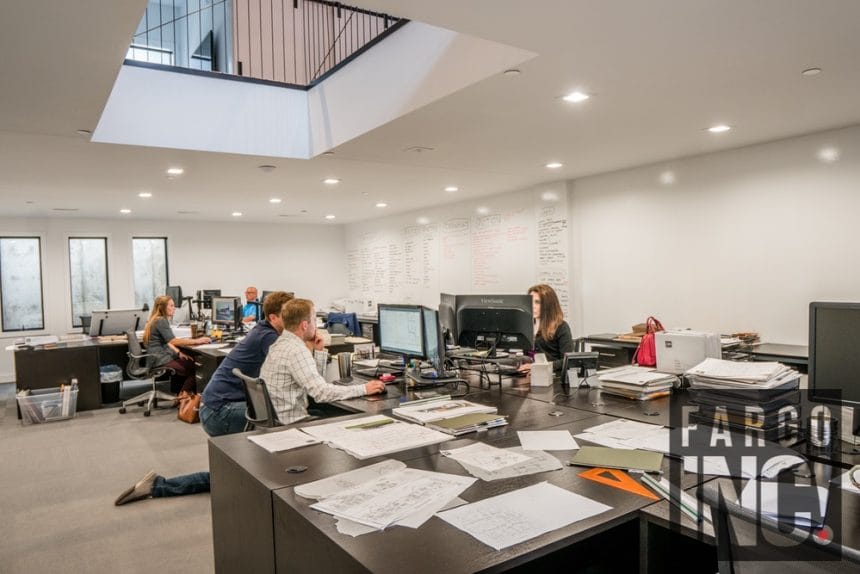Where do you fall on the open-office concept? Love it? Hate it? For some, it’s a godsend and encourages collaboration and creativity. For others, it’s the worst thing around and hinders productivity. It’s Chris Hawley and his team’s job to balance where his customers fall on that and to make sure a customer’s office meets their needs.
Where is office design going? Is the open-office concept fading away?
Open-office is a big thing. The pendulum has swung that nobody has private offices. Whether that’s like Kilbourne Group’s office downtown where you’re all in rows in an open-office. With that situation, you have assigned seats where you show up to your seat every day.
At the very far end of that spectrum is Bobcat. Basically, you show up and you have a locker for the day and you sit at whatever desk is available. That’s kind of the extreme version where you have a mobile office all the time, even when you’re in your headquarters. That’s a big concept. For some people, that’s the greatest thing ever. For others, it’s an awful idea.
I think it should be a blend of open-office and the ability to have a closed-door, whether that’s a phone booth or a small breakout conference room. Even my office is an interesting blend of everybody’s got an open-office with the exception that we have three conference rooms where you can close the door and have a private conversation.
The other thing that I see a lot of and is a part of the discussion as of late is people entertaining out of their office. It’s becoming more than just a bunch of desks. How do you have an entertaining function? If you remember the breakroom, back in the day, it was this back of house windowless room where you use the microwave, sink and that’s about it. It’s very unexciting. I think the breakroom of today is basically a high-end kitchen that people meet at to have discussions and informal meetings to talk about whatever they’re working on. In addition to that, it becomes the hub if they have a larger event where they’re bringing in several different people.
I think Kilbourne has a little bit of that figured out with their Elevate space on the third floor where it transitions from a spot where you can get together, cater some food and have coffee but then there’s a conference room to the side and there’s also the ability to close it down or open it up for a large function. They then can have an all-day thing where they’re entertaining a client or staff at the end of the day. That’s kind of the culture thing where every Friday at 4, you have a happy hour, be on the roof and take people out of the grind of sitting at a desk all day.
We also do a lot of offices where people are like, ‘No, I want a closed door. It’s too distracting not to have a closed door.’ We always start out kind of pushing the envelope a little bit because people are afraid of change and we’re trying to push to have a collaborative, open-air environment. Certain businesses need to have a closed-door office.
I think some ownership things that go with that and it’s kind of an attitude thing where you’re like, ‘Nobody owns this office. I’m only going to be here for a short period.’ Others are like, ‘I’m going to be here for the next 30 years working in this office and, by golly, I’m going to have my own office.’ It almost becomes a status symbol within that office culture, which is really interesting.
Maybe some of the business leaders who have more of an open-office don’t like that. I’m kind of one of those. We’re all on the same playing field and we’re all working collaboratively. There is no hierarchy to what we’re doing. It’s a team environment that requires four different people involved to accomplish a task. They’re all in closed-door offices, it’s a huge disconnect. In a design environment, you do business very informally throughout the day in order to get certain things done. You get something to come to mind and they’re right next to you, you have a quick conversation versus getting out of your desk and going to another part of the building. It’s very inefficient.
Building environmentally friendly and sustainable is becoming more important. Often times, buildings are completely remodeled or torn down in 20-30 years. How can you focus on creating a sustainable office?
Interestingly there is all this modular furniture like DIRTT walls and companies that are towing the adaptability of an office environment in order to change over time. You never throw walls away, you just adapt and change them. Those are way less flexible than one thinks. I think the one thing that I’ve done a lot of that’s very sustainable and adaptable is modular furniture. That is a little looser. It’s almost like Legos.
You pick a table that works for you. You put them together and it acts as a conference room table. Group one of them together and it’s a great workspace for a computer. You can also make it modular to create L and U shapes.
If you walk into our office, people are like, ‘Ooh, nice office.’ The reality is that our office layout changes every three to four months. We adapt because people get shifted around because somebody needs a drafting spot or somebody needs to spread out on a big worktable. That’s the most sustainable way of doing offices, in my mind.








